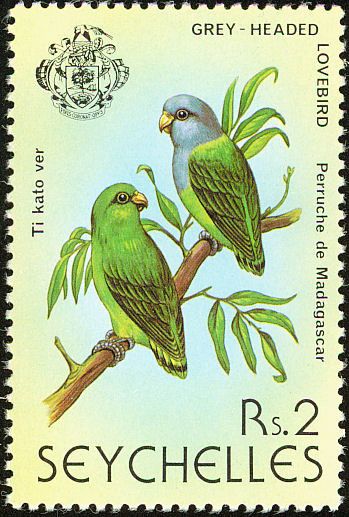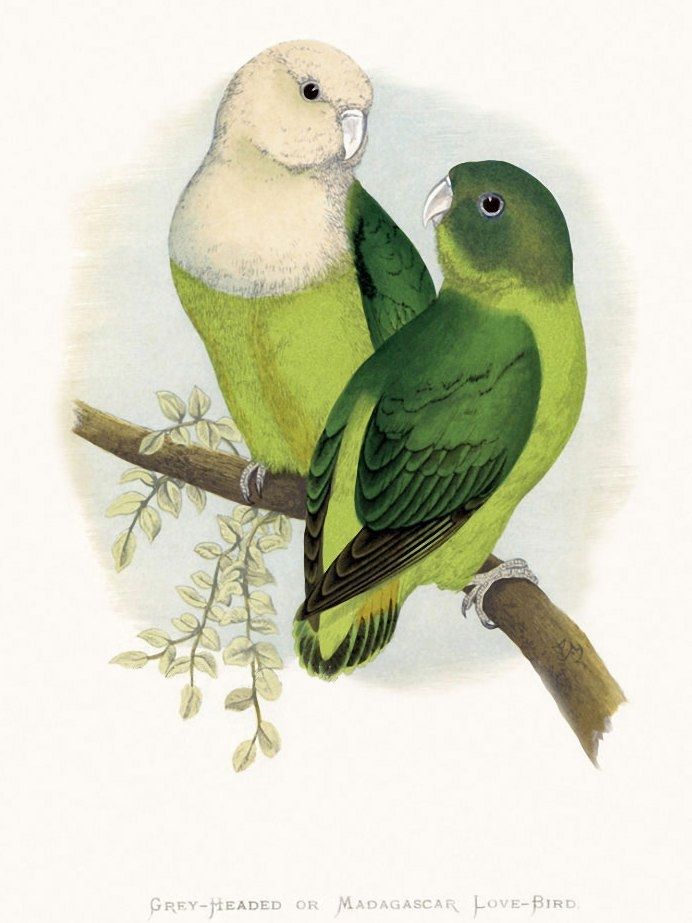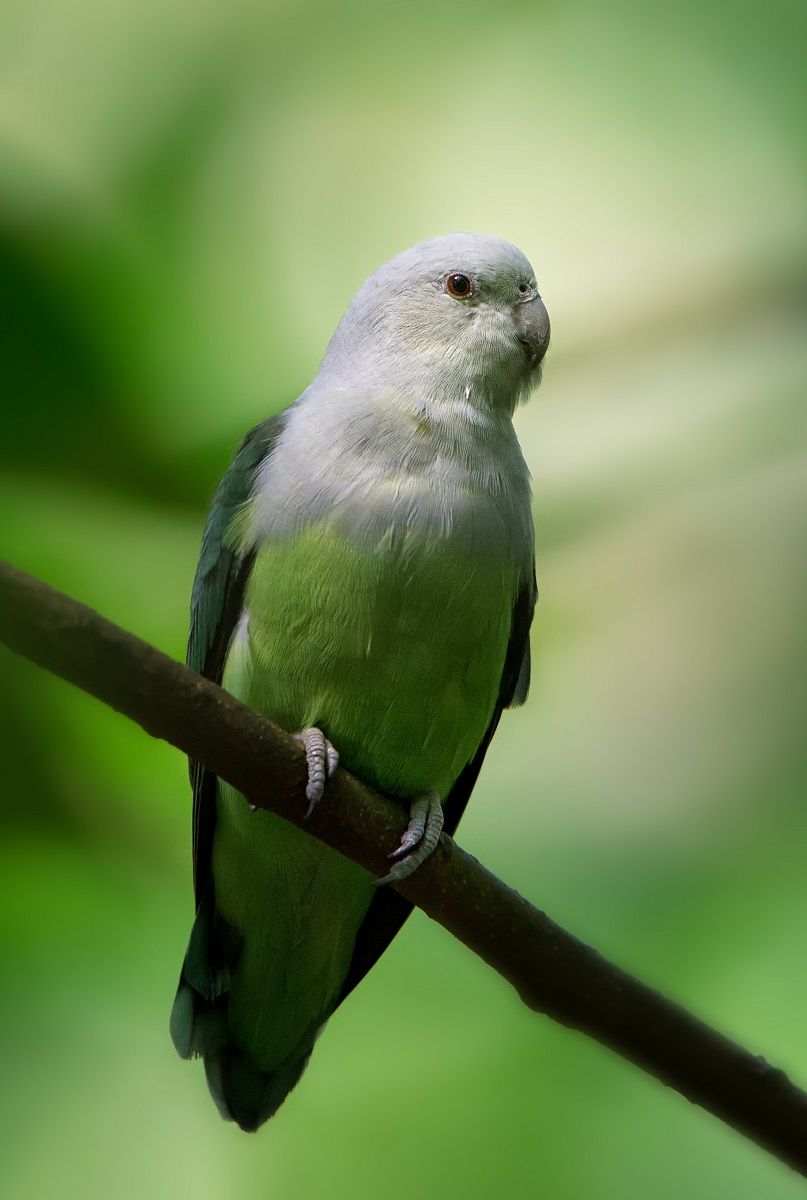The grey-headed lovebird, also known as Madagascar lovebird, is one of the smallest parrots of the genus Agapornis. They’re rarely seen in aviculture, and even hand-fed birds of this species can be shy and nervous. If you’d like to keep one, special care is required.
Read on to find out how to recognize the beautiful grey-headed lovebird, what its diet and breeding habits look like, and how to care for it.
| Name(s) (common, scientific) | Grey-headed lovebird, Madagascar lovebird, Agapornis canus |
| Natural habitat | Island of Madagascar |
| Adult size | Up to 14 cm (5.5″) & between 25–36 grams |
| Lifespan | 10-20 years average |
| Noise level | Medium |
Grey-headed lovebird range & natural habitat
Range
Considering the common name for this bird is “Madagascar lovebird,” it’s not that hard to guess where it comes from! That’s right, Agapornis canus is native to the island of Madagascar, off the African coast.
A small number also occur on neighboring islands, like the Comoros and Réunion. They used to be present on the Seychelles too, after having been introduced by humans, but have since gone extinct there.
Attempts to introduce Agapornis canus on other African islands and the mainland have apparently not been very successful so far.
Did you know? There are two subspecies of Agapornis canus. A. canus ablectaneus is only found in the arid southern regions of the island. A. canus canus occurs everywhere else except the south.
Natural habitat
The grey-headed lovebird can be found throughout Madagascar. It prefers lightly wooded habitats like palm savannahs, forest edges, farmland and the island’s semi-arid scrublands.
The species occurs at an elevation of up to 1,500 meters (around 5,000 ft), often near towns and cities. It travels in small groups of up to a few dozen individuals, sometimes mixed with other bird species.
Threat level
At the time of writing, the IUCN Red List Threatened Species last assessed the grey-headed lovebird in 2018. It has been listed as ‘Least Concern’ with a stable population. There are export restrictions in place, so it’s no longer allowed to catch and sell them abroad.
It’s noted that the species is common in its natural range. Illegal capture does happen, despite these lovebirds not being all that popular in aviculture, but no other significant threats to the population have been identified as of now.

Grey-headed lovebird appearance
Madagascar lovebirds are quite beautiful. They’re easy to recognize by their green body color, with a dark green back and wings. The most striking characteristic about the grey-headed lovebird, though, is of course the male’s pale grey head. The beak is horn-colored, the irises are dark green and the tail shows black markings.
Unlike some other lovebird species, Agapornis canus shows sexual dimorphism. The females lack the typical grey head: they’re entirely green, with darker coloration on the back and wings.
Juvenile Madagascar lovebirds look almost the same as the adults, except the male’s grey head is washed with green. They have a black base and yellow beak.

Grey-headed lovebird diet
In its natural habitat, the grey-headed lovebirds mainly feeds on a variety of grass seeds. One big favorite is rice, which is cultivated in Madagascar and forms a perfect lovebird snack.
It’s difficult to say what a domestic grey-headed lovebird should eat, as there’s not much info out there. They can probably be fed a standard parrot diet, like a mixture of high-quality parrot pellets and a healthy (sprouted) seed mix. Like other parrot species, this lovebird can also learn to enjoy fresh fruits and vegetables.
A varied diet is the key to a healthy bird! Be sure to also always provide multiple sources of fresh water.
Grey-headed lovebird as a pet
The grey-headed lovebird is a very social but also shy species. Even hand-fed birds can be nervous, and they’re generally not cuddly at all. They’re easily spooked and can hurt themselves when frightened. The species is best kept in a large aviary.
If you somehow manage to come across a pair of grey-headed lovebirds for sale, ask yourself if they’re the right pet for you. They’re not considered all that suitable for keeping in the home, and on top of that, they’re pretty fragile.
Even zoos and avian experts sometimes have trouble keeping grey-headed lovebirds. There just isn’t all that much known about their care, and since there are so few out there, it’s unlikely we’re going to figure out anything more soon.
What we do know is that aside from their shyness, grey-headed lovebirds are intelligent and curious. They’re also highly social, so it’s best not to keep them alone. Keeping a pair or small group can help keep their nerves down and ensures they don’t become lonely.

Grey-headed lovebird sounds
Madagascar lovebirds spend much of their day chattering away with their flock members, producing all sorts of squawks and whistling tunes. Their alarm call is especially piercing. Like other parrots, they’re especially vocal at dawn and dusk.
If you want a parrot that you can have long conversations with, the grey-headed lovebird might not be the best choice. They’re not noted to be very talented at mimicking words at all, and they generally prefer to chatter to their own species more than to humans.
You can listen to Agapornis canus on xeno-canto.
Grey-headed lovebird reproduction
In its natural habitat, this lovebird breeds during the rainy season, usually between November and April. Like many other parrot species, it prefers nesting in hollow trees. The nest is built by the female grey-headed lovebird using pieces of leaves, grass and wood.
As is so typical for lovebirds, the female carefully chews nest materials and then tucks them into her feathers to transport them to the nest. She’s also thought to be responsible for incubating the egg clutches, which can contain up to 8 eggs.
As straightforward as all of this sounds, this species is really not very productive in aviculture. It’s considered a serious challenge to breed them, which is also the main reason they’re so rare. They’re considered unsuitable for inexperienced parrot owners.
If you do want to give it a shot, from what I’ve gathered, most types of nest boxes should work. You can supply a variety of nesting material, including branches, coco fiber and whatever else you think the pair might be interested in.
Tip: A short Agapornis canus breeding report can be found at Parrots Daily News. Find them here: Grey-headed lovebirds breeding Part 1 and Part 2.
Do you have any questions about the Grey-headed lovebird? Or would you like to share your own experiences with this unusual lovebird? Leave a comment below, I’d love to hear your story!
Sources & further reading
Reuter, K. E., Rodriguez, L., Hanitriniaina, S., & Schaefer, M. S. (2019). Ownership of parrots in Madagascar: extent and conservation implications. Oryx, 53(3), 582-588.
